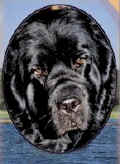|

Seaman accompanied the expedition and alerted Lewis and Clark of unexpected guests.
From the Journals of Meriwether Lewis:
April 22, 1805 : " walking on shore this
evening I met with a buffaloe calf which attached
itself to me and continued to follow close at my heels untill I embarked
and left it. It appeared allarmed at my dog which was probably the cause
of itís so readily attaching itself to me"
 Map
PLUS Lewis and Clark timeline of region (PDF) Map
PLUS Lewis and Clark timeline of region (PDF)
May 29, 1805: Some were curious, "last night we were all allarmed by a large
buffaloe bull, when he came near the tent, my dog saved us by causing
him to change his course"
June 27, 1805 :" a bear came within thirty yards of our camp last night and
eat up about thirty weight of buffaloe suit which was hanging on a pole,
my dog seems to be in a constant state of alarm with these bears and
keeps barking all night"
As the Corps explored the Louisiana Purchase, Lewisí dog was
quickly adopted by the crew and became known as "Our Dog"
Statues Featuring "Seaman" the Discovery Dog on
the Lewis and Clark Trail
St. Louis,
Missouri
St.
Charles, Missouri
Jefferson City, Missouri on the
Missouri State Capitol Grounds
Case
Park - Kansas City, Missouri
Fort Atkinson State Historical Park, Fort Calhoun, Nebraska
Lewis
and Clark Interpretive Center,
Sioux City, Iowa
Washburn, North Dakota at the
Lewis and Clark Interpretive Center
Overlook Park, Great Falls, Montana
Fort
Clatsop National Memorial
Seaside, Oregon
History of the Newfoundland DogThe Newfoundland, a gentle giant among canines, is a striking dog bound
to elicit admiring comments wherever he accompanies his owner. A sweet,
devoted companion, the Newfoundland will protect children, haul
leaves and firewood, save drowning people, and compete successfully in
obedience and tracking trials.
Born as a canine seaman, the Newfoundland was a standard piece of
equipment on every fishing boat in Canada's maritime province that gave
the breed its name. Fishing has always been Newfoundland's chief
industry; the dogs hauled fishing nets out to sea and back to the boat
and retrieved objects or people who fell into the sea. Equally at home
in water or on land, the Newfoundland was large enough to pull in a
drowning man or to break the ice as he dove into the frigid northern
ocean. His lung capacity allowed him to swim great distances and fight
ocean currents.
- At the end of a day's fishing, the day's catch was loaded into a
cart, and the dog was hitched up to haul the load into town. Other
Newfoundlands pulled wagons to deliver milk and mail throughout the
island.
- There are many legends of Newfoundlands saving drowning victims by
carrying lifelines to sinking ships. The dogs were kept in the "dog
walk" on early sailing ships. If the sea was too choppy when land was
sighted, the dog carried a line to land.
- The origin of this working breed is disputed. Vikings and Basque
fishermen visited Newfoundland as early as 1000 AD and wrote accounts of
the natives working side by side with these retrieving dogs. The breed
as we know it today was developed in England, while the island of
Newfoundland nearly legislated the native breed to extinction in 1780.
- The Newfoundland has a stiff, oily outer coat of moderate length and
a fleecy undercoat to adapt to the harsh climate of its home island. The
oil repels water. A Newfoundland can swim for hours, yet remain
completely dry and warm at the skin. The breed has completely webbed
feet and swims with a breast stroke instead of a dog paddle.
|

|

|

|

|

|
|


